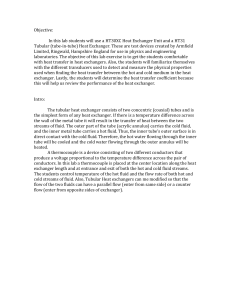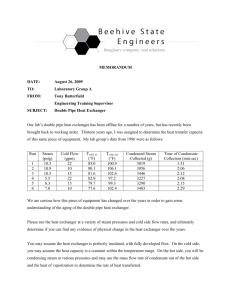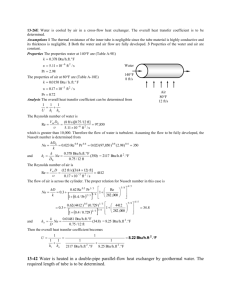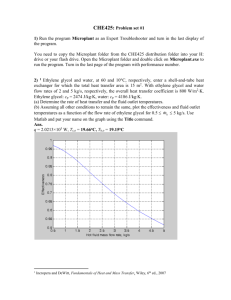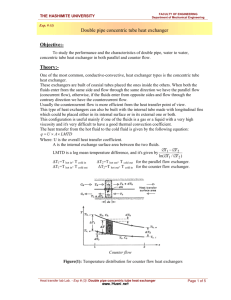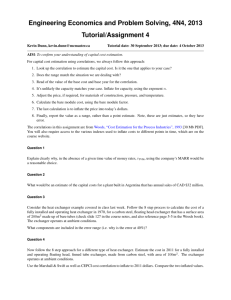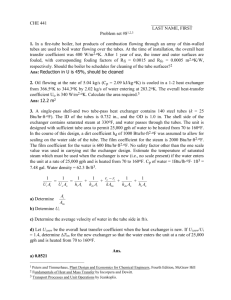Concentric Tube Heat Exchangers
advertisement
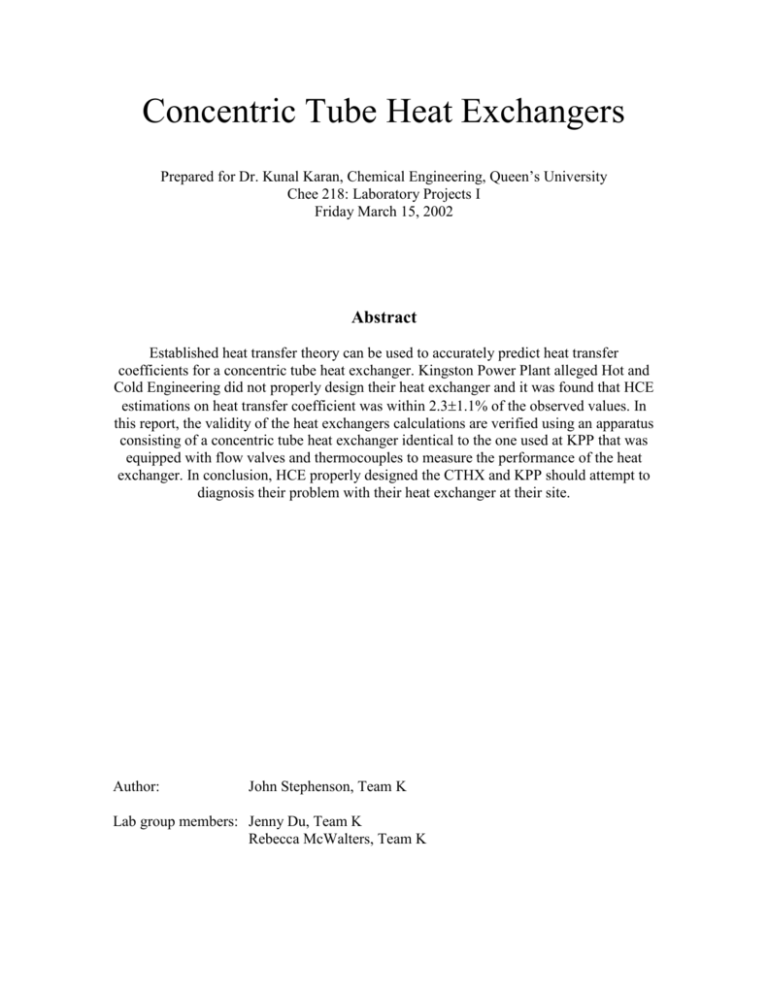
Concentric Tube Heat Exchangers Prepared for Dr. Kunal Karan, Chemical Engineering, Queen’s University Chee 218: Laboratory Projects I Friday March 15, 2002 Abstract Established heat transfer theory can be used to accurately predict heat transfer coefficients for a concentric tube heat exchanger. Kingston Power Plant alleged Hot and Cold Engineering did not properly design their heat exchanger and it was found that HCE estimations on heat transfer coefficient was within 2.31.1% of the observed values. In this report, the validity of the heat exchangers calculations are verified using an apparatus consisting of a concentric tube heat exchanger identical to the one used at KPP that was equipped with flow valves and thermocouples to measure the performance of the heat exchanger. In conclusion, HCE properly designed the CTHX and KPP should attempt to diagnosis their problem with their heat exchanger at their site. Author: John Stephenson, Team K Lab group members: Jenny Du, Team K Rebecca McWalters, Team K 2 Introduction In nearly every engineering operation there usually exists a large array of heat exchangers. They are used to change the temperatures of a fluid stream by passing another fluid close to the desired temperature. The simplest design is a concentric tube heat exchanger (CTHX). It consists of a small inner tube surrounded by larger outer tube. The construction of the CTHX allows the rapid exchange of heat by keeping the two fluids separated by a relatively thin conductive metal tube. Hot & Cold Engineering Company installed a concentric tube heat exchanger at the Kingston Power Plant. The plant is currently using this heat exchanger to cool a stream of hot water to below 95F. Unfortunately their CTHX is not lowering the hot water temperature sufficiently and the chief engineer at the plant is alleging that our engineers did not properly design the equipment. The goal of this report is to determine if the observed overall heat transfer co-efficient is reasonably close to the co-efficient calculated by our senior design engineers. If this is the case, then it can be shown that the calculations made by our design engineers were realistic and the problems encountered at the power plant are not a result of negligence by HCE. A CTHX that is identical in every respect to the one installed at the power plant will be used to gather experimental data on the heat exchanger. The Chemical Engineering department at Queen University’s has graciously allowed our engineering team to perform required experimental testing on our CTHX using one of their facilities located in Dupuis Hall, Room 227. Theory Heat transfer by conduction or convection, Q, in any system is proportional to the temperature difference, T, between the two passing streams and slowed by resistive properties, R, of the materials that the energy must permeate through as shown in Equation 1. Q T R Equation 1 In a heat exchanger calculations it is convenient to modify this equation to express the resistive properties as a function of A, the area of the heat exchanger, and U, the overall heat transfer co-efficient. Q UAT Equation 2 In a heat exchanger, heat is transferred between the bulk of the hot fluid and the bulk of the cold fluid. In the absence of fouling on the tubes present in the heat exchanger there exist three thermal resistances. There exists a convective thermal resistance through the boundary layer formed between the outside surface of the inside pipe and the bulk of the fluid flowing through the outside pipe, 1/hoAo. There is a conductive thermal resistance through the outside and inside surface of the inside pipe, ln (Do/Di) / 2Lkw. Finally there 3 is a convective thermal resistance through the boundary layer formed between the inside surface of the inside pipe and the bulk of the fluid flowing through the inside pipe, 1/hiAi. kw is the conductivity of the wall, Do is the outside diameter of the inside pipe, Di is the inside diameter of the inside pipe, L is the length of the pipe, Ao is the outside area of the inside pipe, Ai is the inside area of the inside pipe, hi is the inside film heat transfer coefficient, and finally, ho is the outside film heat transfer coefficient. To calculate the overall resistance, R, it is just the sum of the three individual R values as shown in Equation 3. (Karan, 2002) R ln( Do / Di ) 1 1 1 UA hi Ai 2k w L ho Ao Equation 3 The values of all the variables are known, except for the film heat transfer coefficients. To understand how this is calculated, Nusselt numbers must be explained. It is a dimensionless number that represents temperature gradient at the surface of the pipe. By finding an empirical method of calculating Nu for the geometries in the heat exchanger and by rearranging Equation 4 we can solve for h to find R and hence Uest. Many empirical correlations exist for finding Nusselt numbers. To find the Nusselt number for flow inside of a pipe Equation 5 is used. For flow inside of the space between two pipes Equation 6 is used. However, we must pay attention to the diameter we use to calculate the Reynolds and Nusselt number. No longer is fluid flowing through a circular pipe, it is flowing through the area between two pipes. Equation 7 illustrates how to calculate the equivalent diameter, Deq, for that geometry. (Perry et. al, 1963) It should be noted that the Prandtl number for any fluid can be looked up in a reference such as Perry’s Handbook or calculated from the fluid properties through its definition, Pr=Cp/kf (Incropera & Dewitt, 2002) Nu hL kf Equation 4 (Incropera & Dewitt, 2002) Nu 0.023 Re 0.8 Pr 0.333 ( Nu 0.02 Re 0.8 Pr 0.333 ( Deq ( Di2,shell Do2,tube ) Do,tube bulk 0.14 ) wall Di , shell Do ,tube ) 0.53 Equation 5 (Perry et. al, 1963) Equation 6 (Perry et. al, 1963) Equation 7 (Perry et. al, 1963) However, as one moves along the profile of a concentric tube heat exchanger, the T varies as each fluid changes temperature. The rate that the temperature changes from the inlet to the outlet of each stream depends on the arrangement of the heat exchanger. Two different configurations are possible. In one scenario, the cool fluid can run parallel to the 4 hot fluid in which case the heat exchanger is said to be in a co-current arrangement. Alternatively the cool fluid can run in an opposite direction to the hot fluid in which case it is in a counter-current arrangement. A corrected T is calculated for the two arrangements and is called the log-mean temperature difference, Tlm. (Equation 8) If the arrangement is co-current Equation 9 is used to calculate T1 and T2, if the arrangement is counter-current Equation 10 is used. (Incropera & Dewitt, 2002) T2 T1 ln( T2 / T1 ) T1 Th,i Tc ,i T T T h ,o c ,o 2 Tlm T1 Th,i Tc ,o T T T h ,o c ,i 2 Equation 8: Calculation Tlm Equation 9: Co-current flow Equation 10: Counter-current flow To solve for Uexp the approach is very simple. With this corrected temperature difference, Equation 2 is modified to look like Equation 11. Then we use our first principles to find the heat transferred through the tube of the heat exchanger, Q, using Equation 11. Finally use both equations, substitute for what is known and solve for Uexp (Equation 13). Q UATlm Equation 11 Qc mc C p (Tc ,o Tc ,i ) U exp Vc C p (Tc ,o Tc ,i ) Dt ,o LTlm Equation 12 Equation 13 5 Experimental Procedure Figure 1. Photograph of Equipment (courtesy of Steve Hodgson) The equipment used for this report is located in Dupuis Hall Room 227 (Figure 1). It consists of three heat exchangers. At the top there is a long, concentric tube heat exchanger identical to the one installed at the Kingston Power Plant and the same used in this experiment. On the bottom there are two shell and tube heat exchangers that were not used for this experiment. The temperatures of the water entering and leaving the heat exchanger are measured by thermocouples and the flow rates of hot and cold water are measured by flow meters. All values are shown on the digital control panel shown on the right of the figure. Outline of Procedure for Co-Current Flow 1. Turn on the digital control panel 2. Open cold water stream. Close valves V12, V23, V11, V22. Open valves V02 (main water inlet) and V31. 3. Open hot water stream. Close valves V35, V32. Open valves V01 (main water inlet), V04, V34 and V33. 4. Monitor the temperature of the cold water in and cold water out using thermocouples 6 and 1. Monitor the temperature of the hot water in and hot water out using thermocouples 5 and 2. Use the flow meter on the panel to read hot and cold water flow rates. 5. Select a fixed turbulent hot water flow rate and vary cold water for 4 runs. Select a fixed turbulent cold water flow rate and vary hot water for 4 runs. Vary both for 4 runs. 6. Close V01 and V02 to stop water flow 6 Outline of Procedure for Co-Current Flow 1. Open cold water stream. Close valves V12, V23, V11 and V22. Open valves V02 (main water inlet), V31. 2. Open hot water stream. Close valves V34 and V33. Open valves V01 (main water inlet), V04, V35 and V32. 3. Monitor the temperature of the cold water in and cold water out using thermocouples 6 and 1. Monitor the temperature of the hot water in and hot water out using thermocouples 3 and 4. Use the flow meter on the panel to read hot and cold water flow rates. 4. Select a fixed turbulent hot water flow rate and vary cold water for 4 runs. Select a fixed turbulent cold water flow rate and vary hot water for 4 runs. Vary both for 4 runs. 5. Close valves V01 and V02 to stop water flow 6. Turn off digital control panel Safety Safety goggles were worn at all times by all members of the team. Permission to use the equipment was obtained from the lab supervisor All experimental work was supervised Fire exits were noted No materials (e.g. toxic, flammable, corrosive) or equipment requiring other safety precautions were handled. Results & Discussion All data collected from the experimental procedure was placed into a spreadsheet and using a spreadsheet that had been designed by R. Crews. This spreadsheet calculates the tube-side and shell-side film heat transfer co-efficient. Then it uses this data to calculate Uest. Modifications to this spread sheet were made to allow it to calculate Uemp and to verify that Cp is not a strong function of T, which if it was could alter the calculation of Prandtl numbers.and of Q. It was found that Cp remains nearly constant around 1 Btu/lbm°F over the range of temperatures that the data was collected at. Finally using the outside area of the tube, and calculations of Q as summarized by Equation 13. The calculations are nearly trivial in nature and outlined in more detail in the spreadsheet. Figure 2 was made to illustrate how close of a fit the estimated values of the heat exchanger co-efficient and the experimental values were. As can be seen, the relationship follows a nice straight line with a slope of 1.0 and an R2 = 0.98. These values, showing a nice trend, are hard to translate into tangible terms. So, the percentage difference of Uexp from Uest was calculated for each trial, averaged and the 95% confidence interval taken. It was found that the average difference of two the quantity was 2.31.1%. Meaning that this small variation in heat transfer co-efficients could not have led to the poor performance experienced at the KPP, this variation could have only introduced one or two degrees Fahrenheit of uncertainty over a cooling range of 50-100F. It is possible that the poor performance of KPP’s heat exchanger is a result of fouling on the pipes 7 from the Lake Ontario water that it draws. Lake Ontario water is quite hard and KPP should try to flush their heat exchanger with dilute acid to remove any calcium build-up. The slope in Figure 3 is 1.09 and the graph shows that more heat is being transferred from the hot water than from the cold water. The difference can be easily explained. The hot water is not only exchanging heat with the cold water as it runs through the shell, but it is exchanging heat to the atmosphere. As expected, and in every case, Qh is greater than Qc. As can be seen in Figure 4 the heat transfer co-efficient drops as the Reynolds number of the inside and outside area of the heat exchanger increases. This shows that the heat exchange becomes less efficient as the flow rates increase. Quantitatively more heat may be exchanged between the fluids, but the temperature change of the two fluids, Tlm, is lessened in Equation 11. Conclusions and Recommendations The logic behind the calculations used by Hot and Cold Engineering to find the heat transfer co-efficient in the concentric tube heat exchanger installed at KPP is justified. The average difference of predicted and experimental quantities was quite small for calculations of this kind, 2.31.1%. It is possible that the poor performance with the KPP’s concentric tube heat exchanger may be due to fouling on the pipes. The KPP draws hard water from Lake Ontario and this could have lead to the fouling. KPP should try to flush their heat exchanger with dilute acid to remove any calcium build-up. 8 References Crews, R, 2000. “Heat Exchanger Excel Spreadsheet”, http://info.chee.queensu.ca/CHEE218/Labs/Heat%20Exchanger/Student %20-%20HX.xls De Nevers, Noel, 1991. “Fluid Mechanics for chemical engineers”, 2nd Edition, McGraw-Hill, NY Incropera, F.P. and DeWitt, D.P., 2002. "Fundamentals of Heat and Mass Transfer", John Wiley & Sons, 5th Edition, Chapter 11 Karan, Kunal, 2002. "Heat Exchanger", http://info.chee.queensu.ca/CHEE218/Labs/Heat%20Exchanger/heatex.htm Perry, R.H., C.H. Chilton and S.D. Kirkpatrick, 1963. "Chemical Engineers' Handbook," 4th Edition, McGraw-Hill, N.Y.

